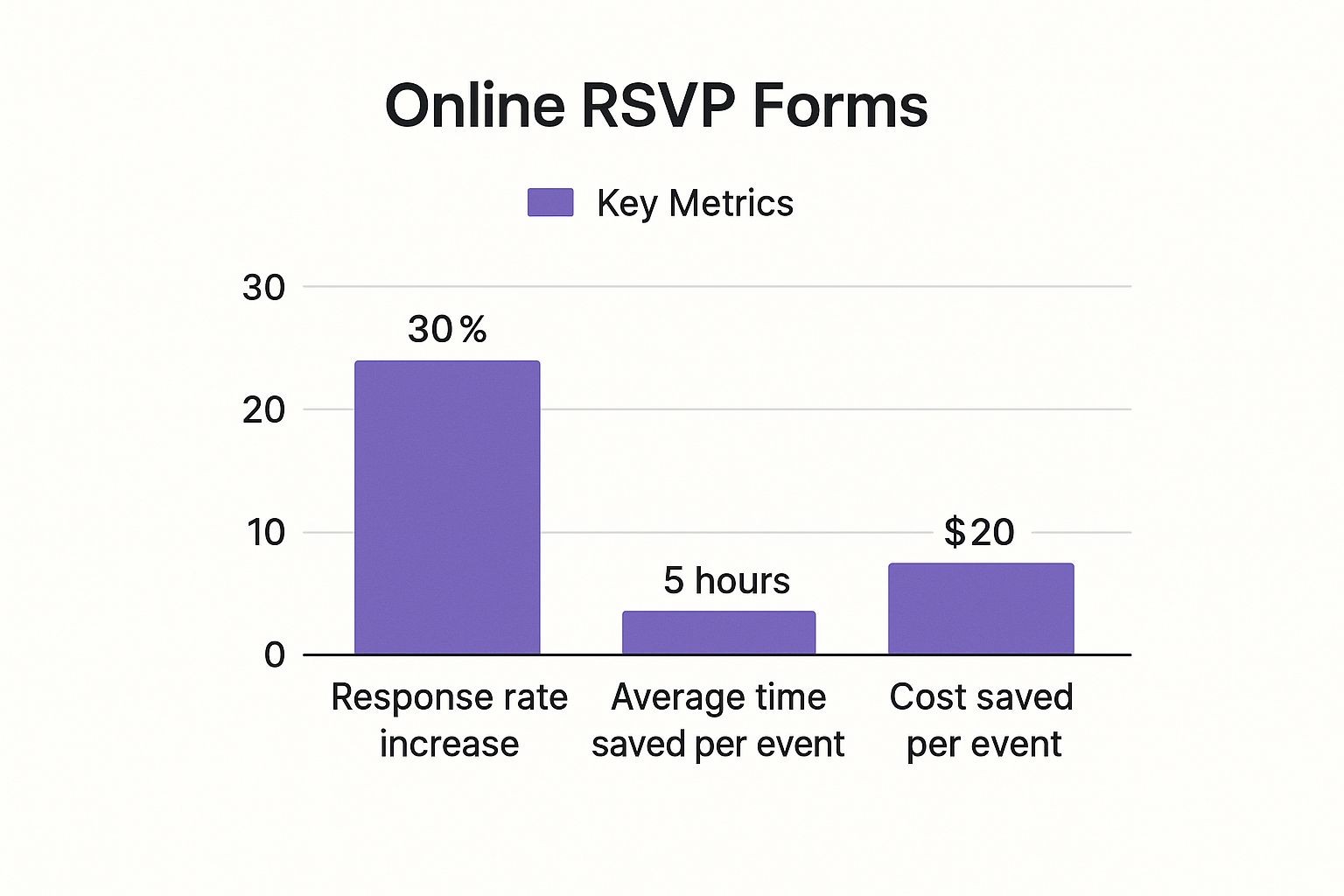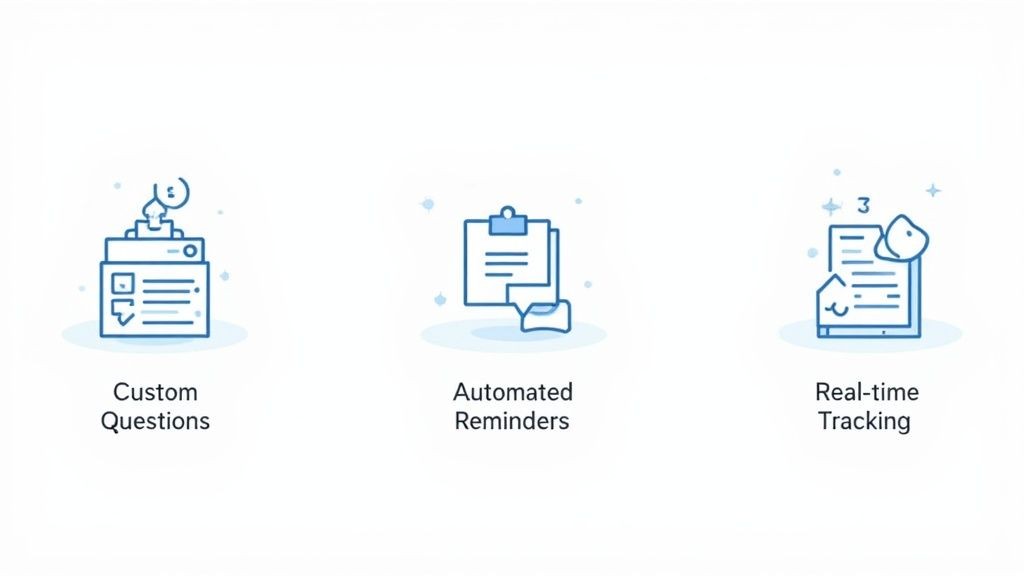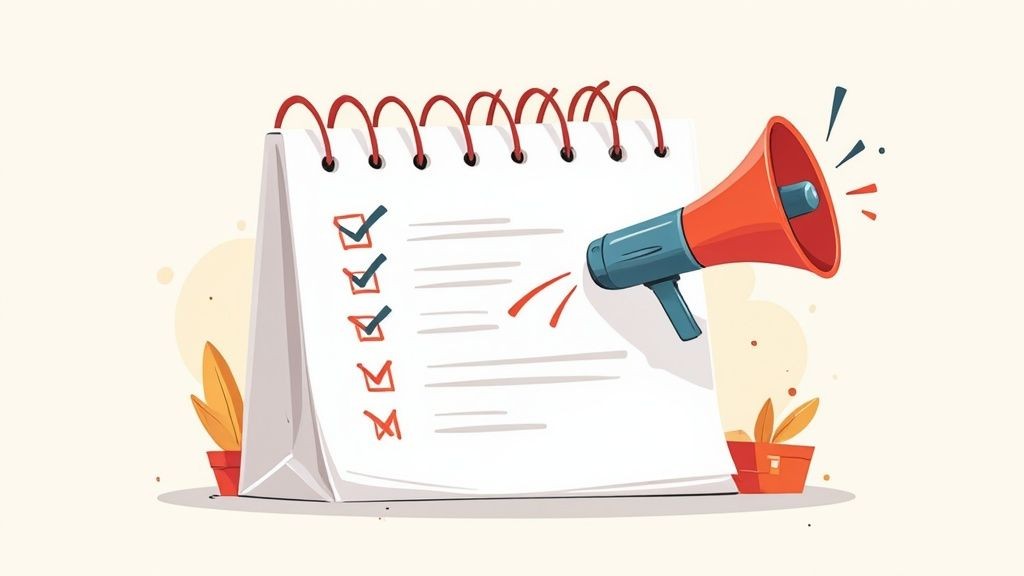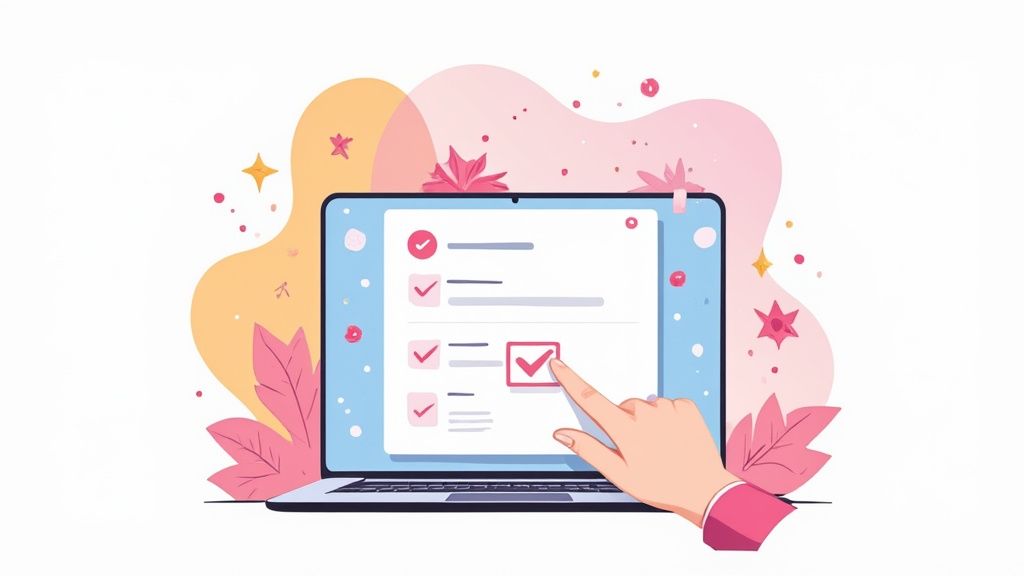Online RSVP forms are a lifesaver for anyone planning an event. They ditch the old-school paper replies for a slick digital system that makes gathering guest info - whether for a corporate webinar or a wedding - incredibly simple.
Why Online RSVPs Are a Game Changer for Event Hosts
Remember the days of chasing down guests for a response and wrestling with messy spreadsheets? Gone. Switching to online RSVP forms has completely changed the game for managing events, making life easier for everyone. From our position at Add to Calendar PRO, we’ve seen countless event organizers reclaim hours of their day just by making this simple digital shift.
This move just solves so many of the classic event-planning headaches. Inaccurate headcounts, mail getting lost, and disorganized data can turn an exciting event into a logistical nightmare. Digital RSVPs are the elegant fix.
Let's quickly look at how they stack up against the old way of doing things.
Traditional vs. Online RSVP Forms at a Glance
For anyone still on the fence, this table breaks down the core differences. The advantages of going digital become pretty clear when you see it all laid out.
| Feature | Traditional RSVP (Paper) | Online RSVP Forms |
|---|---|---|
| Response Time | Days to weeks (mail delivery) | Instant, real-time updates |
| Accuracy | Prone to manual entry errors | Highly accurate, no data entry required |
| Cost | Printing, postage, return envelopes | Often free or low-cost for basic features |
| Guest Experience | Requires filling out and mailing a card | Quick and convenient (a few clicks) |
| Data Management | Manual tracking (spreadsheets) | Automated, exportable guest lists |
| Communication | Limited to the initial invitation | Easy to send automated reminders & updates |
The bottom line? Online forms offer a faster, cheaper, and far more organized way to manage your guest list.
The Power of Instant Data and Automation
One of the biggest wins is getting a precise, real-time headcount. The moment a guest replies, their response is logged. This means you can make confident, timely decisions about catering, seating charts, and venue capacity without any of the usual guesswork.
And the automation? It’s a huge time-saver. You can set up automatic confirmation emails, schedule event reminders as the date gets closer, and even ping anyone who hasn't responded yet. This kind of proactive communication keeps your event on people's radar and seriously helps cut down on no-shows.
For hosts, this means less time spent on tedious follow-ups and more time to focus on what really matters: creating an amazing event experience. You get to manage your guest list with total confidence.
Cost and Time Efficiency
It’s no surprise that online RSVP forms have taken off - they’re just incredibly efficient. The best tools now let you handle invitations, collect responses, and manage all your event logistics in one place. We’re talking about more than just a digital replacement for mail-in replies; many platforms offer built-in features for seating charts, ticket sales, and automated reminders that streamline the whole process. You can learn more about how these tools have evolved from the experts at RSVPify.
This all adds up to real savings in both time and money. The data below speaks for itself, showing the average efficiency boost event hosts see after going digital.

The numbers don't lie. There's a clear jump in response rates and a significant drop in the time and money spent per event. For anyone organizing an event, big or small, making the switch to digital is a no-brainer.
How to Choose the Right RSVP Platform for Your Event
With so many tools out there promising to create the perfect rsvp forms online, it’s easy to feel a bit lost. You’ve got everything from dead-simple free builders to massive event management platforms. The trick is finding one that actually fits what you’re trying to do without a bunch of features you’ll never touch.
Working with event organizers every day, we've seen that it really boils down to two things: usability and scalability. Is it easy for you to set up and even easier for your guests to use? And can it grow with you, whether you’re going from a small workshop to a big conference?
Define Your Core Needs First
Before you even start looking at platforms, stop and figure out what you actually need. It's tempting to get sidetracked by flashy features, but most of them are just noise.
Start by asking yourself a few simple questions:
- What's my budget? Are you trying to do this for free, or can you spend a little for a more polished experience?
- How many people are coming? A tool designed for a 20-person meetup is very different from one built for a 500-person conference.
- How tech-savvy am I? Do you need a simple drag-and-drop builder, or are you okay with something more involved?
Nailing these down first will save you a ton of time by immediately filtering out the tools that are a poor fit.
Must-Have Features to Look For
Once you know what you need, you can start comparing the options. Some tools are just about building a form, while others - like our service - weave RSVP features into a broader set of event marketing tools.
Here’s what we consider essential:
- Customization: Can you make it look like your event? Adding your logo, brand colors, and custom questions makes a huge difference and just feels more professional.
- Integrations: Does it play nice with the other tools you already use, like your email marketing platform or calendar apps?
- Data Management: How easy is it to see who’s coming? You’ll want a simple way to view, sort, and export your guest list, ideally in real-time.
The demand for digital event tools is only growing. North America alone now makes up about 35% of the electronic invitation software market, which just shows how common this has become. It’s all about giving hosts better tools to track attendees and create a smoother experience for guests.
The right platform isn't just about collecting a "yes" or "no." It’s about creating a seamless process that saves you a headache and gives your guests a great first impression.
Finding that sweet spot between simplicity and power is the real goal. To get a better sense of what's out there, take a look at our guide on the top online RSVP services. It breaks down the different types of platforms and what they do best.
Alright, let's get our hands dirty and build your first RSVP form. This doesn't have to be some intimidating, complicated process. The real goal is to create something that’s dead simple for your guests to fill out, while still getting you all the information you need to plan your event without pulling your hair out.

Think of your form as a quick, friendly chat with your guests. You only want to ask enough to be prepared, not so much that it feels like they're filling out a tax return. A form that's too long or confusing is the number one reason people just give up and close the tab.
Nailing the Absolute Essentials
Every single RSVP form, no matter the event, needs a few core pieces of information. These are your non-negotiables - the foundation of your guest list.
You can get by with just these three fields:
- Guest Name: A simple text field labeled "Full Name" is perfect. No need to overcomplicate it.
- Contact Information: An email address is the gold standard here. This is your lifeline for sending confirmations, last-minute updates, or even a thank you note after the event.
- Attendance Status: This is the whole point, right? Use a multiple-choice question with crystal-clear options like "Joyfully Attending" and "Regretfully Declining."
That's it. With just those three fields, you have a fully functional form. For a lot of smaller, more casual events, this might be all you need to get a solid headcount.
Asking Smarter Questions for Better Planning
Once you've got the basics down, you can start adding questions that will genuinely make your life as a host easier. This is where you collect the details that elevate an event from good to great. The trick is to only ask for information you’re actually going to use.
Consider adding a few strategic fields for things like:
- Plus-Ones: A simple dropdown or a number field asking "Number of Guests" clears up any confusion about who’s coming.
- Meal Preferences: If you're serving food, this is a must. A checklist or multiple-choice question for dietary needs (e.g., Vegetarian, Gluten-Free, Allergies) is a lifesaver.
- Accessibility Needs: A simple, open-ended question like, "Do you have any accessibility requirements we should be aware of?" shows you’re a thoughtful host who cares about everyone's experience.
This is something we focused on with our service. We made it incredibly easy to add these kinds of custom fields with just a few clicks. It helps hosts prepare for anything without overwhelming their guests with a massive form. The structure of your form is just as important as the questions themselves, which is something we dive into in our guide on the best practices for form design.
The most effective RSVP forms have a logical flow. Group related questions together: get their contact info first, then their attendance status, and finally, ask logistical questions like meal choices. This natural progression makes the form feel faster and more intuitive for your guests.
By keeping your form focused and user-friendly, you're not just gathering data. You're creating a positive first impression for your event, which encourages more people to respond and sets a professional, organized tone right from the start.
Making a Great First Impression with a Branded Form
Let’s be honest, your RSVP form is more than just a data collection tool. It’s often the very first direct interaction a guest has with your event, and you know what they say about first impressions.
A generic, unstyled form feels a bit like a flat-pack manual - functional, but totally devoid of personality. On the other hand, a beautifully branded one instantly builds credibility and starts generating excitement from the moment they click the link. Think of it as rolling out the digital red carpet.
Your Form is Part of Your Event Identity
The key here is consistency. Your RSVP form should feel like a natural extension of your invitation, your website, or your social media presence. The colors, fonts, and overall design need to feel familiar and cohesive, reinforcing the unique vibe of whatever you're planning. A sleek, minimalist form is perfect for a corporate webinar, but you’d want something more playful and vibrant for a creative workshop.
Before you even dive into the styling options, get your core brand assets ready. A little prep work here goes a long way in making your form look intentional and professional, not like a last-minute afterthought.
You'll want to have these handy:
- Your Logo: Grab a high-resolution version of your event or company logo. You'll want to place this right at the top, usually in the header, so it's the first thing people see.
- Color Palette: Know your primary and secondary brand colors. Using these for backgrounds, buttons, and text is the quickest way to create a cohesive look.
- Typography: If you have specific brand fonts, use them. If not, pick a couple of clean, readable web fonts that match your event's personality.
Putting these elements into action is what transforms a standard template into a custom touchpoint. For instance, with a tool like ours, you can easily upload a logo and plug in the hex codes for your colors. This ensures the form perfectly matches your website or email invitation. It's a small effort, but it makes a huge difference in how attendees perceive the quality of your event.
A well-designed RSVP form does more than just look good - it builds trust. When the visual experience is seamless from the invitation to the form, it tells guests you're organized, professional, and care about the details.
Practical Styling Tips That Make a Difference
Beyond logos and colors, a few smaller details can really elevate the user experience. You don’t need to be a designer to make smart choices that guide your guests through the form and, most importantly, get them to hit "submit."
Here are a few areas to focus on for maximum impact:
- Buttons: Your "Submit" or "RSVP Now" button needs to pop. Use a bold, contrasting color from your palette to draw the eye and create an unmissable call to action.
- Headers and Backgrounds: A custom header image or even just a subtle background color can add a splash of personality. Just be careful it doesn't distract from the actual questions.
- Readable Fonts: This one’s crucial. Prioritize legibility above all else. Steer clear of overly decorative or script fonts for body text, and make sure there's enough contrast between your text and background colors.
By investing a little time in branding your rsvp forms online, you create a polished, engaging experience that sets a positive and professional tone long before the event even begins.
Sharing Your Form to Maximize Responses

You've put in the work and built a beautiful, branded form. But a perfect form that no one sees is... well, useless. Now comes the part that actually matters: getting it in front of your guests.
Your distribution strategy is everything. The goal is to make replying as easy and frictionless as possible. That means meeting your audience where they already are, whether that's on your website, in their email inbox, or scrolling through social media.
Embedding Your Form Directly on Your Website
If you have a dedicated event page on your website, embedding your rsvp forms online is almost always the best move. It creates a completely seamless experience. Visitors can learn about the event and confirm they’re coming without ever leaving the page.
Embedding is the way to go when:
- You want to keep visitors on your site. Fewer clicks mean fewer chances for people to get distracted and drop off.
- Your website already gets decent traffic. Why not capture RSVPs from the audience you've already built?
- A cohesive brand experience is important. An embedded form feels like a natural part of your event's online home.
This approach keeps the user journey clean and simple, which is a proven way to get more people to hit that "submit" button.
Sharing a Direct Link for Maximum Reach
Sometimes, you just need a simple, versatile link. A dedicated URL for your form can be shared across pretty much any channel you can think of, giving you incredible reach and making it dead simple for guests to respond.
This is the perfect approach for:
- Email Invitations: Drop a clear, bold link or a button in your email that takes people straight to the form. No fuss.
- Social Media: Pop the link in your bio, create a post about it, or add it to your event page to grab your followers' attention.
- Printed Materials: For physical invitations or flyers, a shortened link or a QR code is a fantastic touch. Guests can just scan it with their phone and land right on the RSVP page.
The simpler you make it for someone to find and fill out your form, the more likely they are to actually do it. Your job is to remove every possible barrier.
Go a Step Further with Smart Integrations
Getting the RSVP is only half the battle. The real goal is making sure your guests actually show up. This is where a smart integration can make a huge difference.
For instance, with a service like our own Add to Calendar PRO, you can automatically show an "Add to Calendar" button on the confirmation screen right after someone RSVPs.
It sounds simple, but this feature is incredibly powerful. It lets your guests instantly add the event to their personal calendar, which drastically reduces the chances of them forgetting about it. It’s a small detail that not only improves the guest experience but also helps you plan with a much more accurate headcount by cutting down on no-shows.
Managing RSVPs and Communicating With Your Guests
Your beautiful rsvp forms online are live and the responses are starting to trickle in. This is where the real fun starts - turning that guest data into an organized, unforgettable event. Your RSVP system stops being just a collection tool and becomes your central command hub for guest management.
The first thing you’ll want to do is get comfortable with your dashboard. Most modern platforms give you a real-time overview of your guest list, letting you see who has responded, who’s attending, and who had to decline. This immediate access to attendance numbers is gold for making quick, informed decisions on everything from catering counts to seating charts.
Turning Raw Data Into Actionable Insights
Just collecting names and email addresses isn't enough; you need to be able to manage that information without pulling your hair out. A non-negotiable feature for any RSVP tool is the ability to easily view, sort, and export your guest list. Whether you need a simple CSV file for your check-in table or want to filter responses by meal preference, this functionality is an absolute lifesaver.
For instance, you might need to:
- Export a list of just the "Attending" guests to send over to your venue.
- Filter by dietary restrictions to give your caterer a precise count for each meal type.
- Sort by plus-ones to start tackling the puzzle of your seating chart.
This level of organization is what prevents those frantic, last-minute scrambles and makes you look like you’ve got it all under control. For a deeper dive into different methods, you can check out our guide on how to track RSVPs online. A good system automates this, saving you from hours of staring at a spreadsheet.
The goal is to move beyond a simple headcount. Your RSVP data should empower you to anticipate what your guests need and create a more personalized, thoughtful event experience for them.
Proactive Communication Is Key
Your job isn't done the moment a guest clicks "submit." Smart, timely communication before, during, and after the event is what keeps your attendees engaged and in the loop. This is where automation becomes your best friend.
A fantastic place to start is with an automated confirmation email. The instant someone RSVPs, they should get a message right in their inbox confirming their response. This email should reiterate key event details like the date, time, and location. It’s a simple touch that reassures them their response went through and reinforces the information.
As the event gets closer, sending a timely reminder or two can seriously cut down on no-shows. We've found that a quick email a week before, and another the day before, is the sweet spot. It keeps your event top of mind and helps build a little excitement.
Handling Tricky Situations Gracefully
Let's be real - event planning always throws a few curveballs. Last-minute cancellations, unexpected plus-one requests, and even managing a waitlist are all part of the game. A good online RSVP system helps you handle these little hiccups without breaking a sweat.
If a guest needs to change their mind, a great platform will let them update their own submission, which then automatically tweaks your guest list numbers. For those sold-out events, some tools even offer waitlist functionality, automatically pinging the next person in line if a spot opens up. Handling these changes through the system keeps your records clean and saves you from a messy inbox full of one-off requests. It’s all about staying organized, no matter what surprises come your way.
Ready to manage your next event with confidence? Add to Calendar PRO provides a powerful, all-in-one solution for creating custom RSVP forms, tracking attendees, and communicating with your guests. https://add-to-calendar-pro.com



